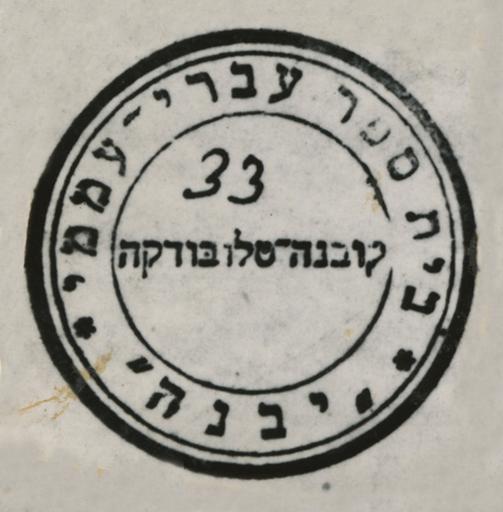MAKE A MEME
View Large Image

| View Original: | Elementary_School_–_Yavneh_–_Kovno-Slobodka.jpg (591x601) | |||
| Download: | Original | Medium | Small | Thumb |
| Courtesy of: | www.flickr.com | More Like This | ||
| Keywords: hardware = epson expression 100 hardwareepsonexpression100 software = epson scan v2.20a an softwareepsonscanv220aan circle round dial Founded in Vilna in 1902, Mizrahi was an Orthodox Zionist movement whose slogan was “The Land of Israel for the People of Israel according to the Torah of Israel” – contrary to many Zionist movements’ secular focus, Mizrahi rooted its ideology in religious interpretation. In its early years Mizrahi experienced significant growth with more than two hundred branches of the organization springing up across regions of Eastern Europe – representing some 11,000 members. The size and influence of Mizrahi ebbed and flowed throughout the early 1900s as the organization struggled with political repression and as it competed with other Zionist organizations for influence. While the youth movement affiliated with the organization – Tse’ire Mizrahi – was active in promoting immigration to Palestine, the larger organization’s activities were focused around Judaic and Hebrew education as well as holding prayer services. Mizrahi was active in setting up educational institutions across many regions in Eastern Europe, these schools were known as the “Yavneh” school network. Home to a vibrant – as well as religiously and politically diverse – Jewish community, Kovno had a variety of different schools run by a range of different organizations; and as this book stamp makes clear this included an elementary school from the Yavneh network located in Slobodka, a community on the Eastern side of the Neris River. Slobodka was the main site of the Kovno ghetto. This book stamp is from a book looted by the Nazis and sorted by Colonel Seymour Pomrenze, one of “the Monuments Men,” at the Offenbach Archival Depot. There are two scrapbooks of archival markings from the books sorted at the Offenbach Depot in the Seymour Pomrenze Collection held by the American Jewish Historical Society (Call number P-933) There is a finding aid for the collection here The digitized scrapbooks are available here and here. For more information on this project check the Center’s blog: 16thstreet.tumblr.com/tagged/Offenbach-Depot Dr. Mitch Fraas, Acting Director of the Digital Humanities Forum at the University of Pennsylvania Libraries' Special Collections Center is working on a similar project for the German book stamps based on NARA microfilm of the volumes the American Jewish Historical Society currently holds. See viewshare.org/views/mfraas/offenbach-bookplates/ The Center for Jewish History would like to acknowledge the following: The American Jewish Historical Society, who graciously allowed the use of their archival materials and digital content; Mitch Fraas, Acting Director of the Digital Humanities Forum at the University of Pennsylvania Libraries' Special Collections Center, for his data and technical assistance in this project; David Rosenberg, Reference Services Research Coordinator, and Melanie Meyers, Senior Reference Services Librarian for Special Collections, for managing and creating the digital map; and Reference Services Librarian Ilya Slavutskiy for his work on translating and mapping. For copyright information, click here Founded in Vilna in 1902, Mizrahi was an Orthodox Zionist movement whose slogan was “The Land of Israel for the People of Israel according to the Torah of Israel” – contrary to many Zionist movements’ secular focus, Mizrahi rooted its ideology in religious interpretation. In its early years Mizrahi experienced significant growth with more than two hundred branches of the organization springing up across regions of Eastern Europe – representing some 11,000 members. The size and influence of Mizrahi ebbed and flowed throughout the early 1900s as the organization struggled with political repression and as it competed with other Zionist organizations for influence. While the youth movement affiliated with the organization – Tse’ire Mizrahi – was active in promoting immigration to Palestine, the larger organization’s activities were focused around Judaic and Hebrew education as well as holding prayer services. Mizrahi was active in setting up educational institutions across many regions in Eastern Europe, these schools were known as the “Yavneh” school network. Home to a vibrant – as well as religiously and politically diverse – Jewish community, Kovno had a variety of different schools run by a range of different organizations; and as this book stamp makes clear this included an elementary school from the Yavneh network located in Slobodka, a community on the Eastern side of the Neris River. Slobodka was the main site of the Kovno ghetto. This book stamp is from a book looted by the Nazis and sorted by Colonel Seymour Pomrenze, one of “the Monuments Men,” at the Offenbach Archival Depot. There are two scrapbooks of archival markings from the books sorted at the Offenbach Depot in the Seymour Pomrenze Collection held by the American Jewish Historical Society (Call number P-933) There is a finding aid for the collection here The digitized scrapbooks are available here and here. For more information on this project check the Center’s blog: 16thstreet.tumblr.com/tagged/Offenbach-Depot Dr. Mitch Fraas, Acting Director of the Digital Humanities Forum at the University of Pennsylvania Libraries' Special Collections Center is working on a similar project for the German book stamps based on NARA microfilm of the volumes the American Jewish Historical Society currently holds. See viewshare.org/views/mfraas/offenbach-bookplates/ The Center for Jewish History would like to acknowledge the following: The American Jewish Historical Society, who graciously allowed the use of their archival materials and digital content; Mitch Fraas, Acting Director of the Digital Humanities Forum at the University of Pennsylvania Libraries' Special Collections Center, for his data and technical assistance in this project; David Rosenberg, Reference Services Research Coordinator, and Melanie Meyers, Senior Reference Services Librarian for Special Collections, for managing and creating the digital map; and Reference Services Librarian Ilya Slavutskiy for his work on translating and mapping. For copyright information, click here | ||||